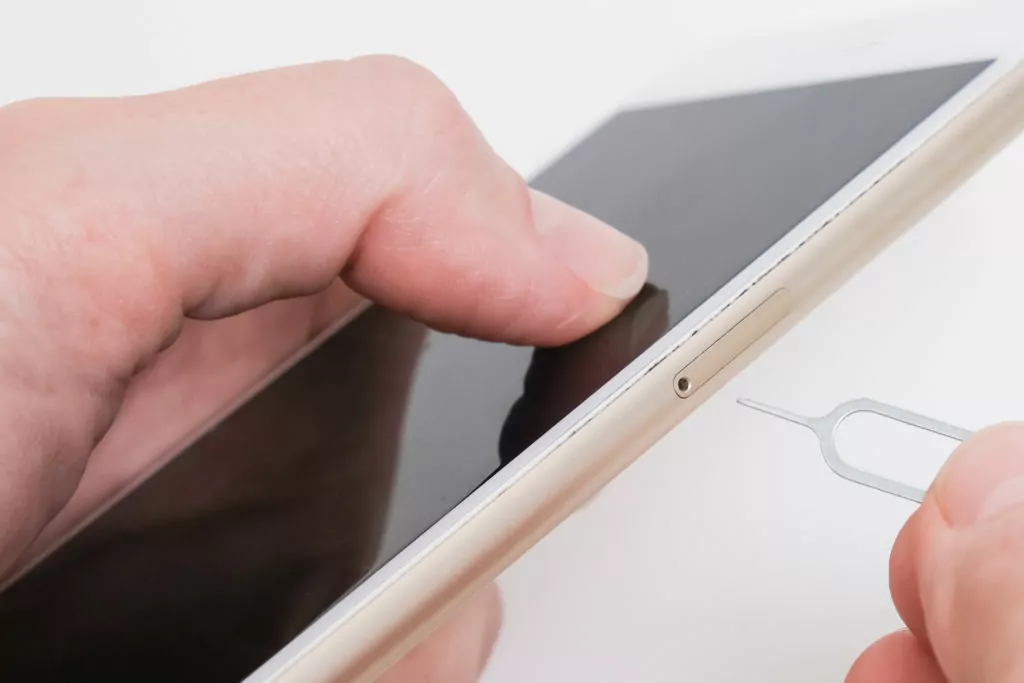Here’s whether you have to turn off your phone to change the SIM card:
New phones typically do not require you to power them off when you change the phone.
Older models with a removable battery normally do require you to turn the phone off.
If you’re not sure about your particular model, you can look it up in the user’s manual or just turn off the phone to be safe.
If you want to learn all about whether it’s safe to change your SIM card without turning your phone off, then this article is for you.
Let’s get started!
- Using Phone SIM Card in Mobile Router: Can You?
- Phone SIM in Tablet: Using Data Service?
- SIM Card Stolen: What Can Someone Do With Your SIM Card?
- Using One SIM Card With Two Phones: How to?
- Taking SIM Card Out & Putting Back In Later: Getting Texts?
- How to Connect to Wi-Fi Without a SIM Card?

How Can Changing the SIM Card Hurt a Phone? (2 Things)

How would changing your SIM card even damage a phone?
It seems kind of strange, especially since so many phones seem fine when you swap the card.
There are two areas of concern.
The first is induced currents that can physically damage a phone.
The second is software confusion that can impact the phone’s functionality.
#1 Induced Currents

Here’s how it works. Your phone has a bunch of electricity running through all of the parts at different times.
Those active currents create magnetic fields that can induce currents in parts of the phone that aren’t active.
So if the phone is on but not currently being used, electricity is still flowing through many points in the device.
For the most part, this is fine.
Everything is designed to handle that flow of electricity, so it’s no problem.
But, when you remove a component with electricity actively running through it, it can cause damage to the small and delicate circuitry.
This is why old phones required you to power off the phone before pulling the SIM card.
That said, modern phone design uses SIM trays with a clever eject sequence.
The ejection stops all flow of electricity before the card pulls free.
This simple feature provides good protection, and pulling the SIM card will only cause damage if something malfunctions.
#2 Software Issues

The other reason to power down the phone is that you are changing part of the phone’s hardware when you swap your SIM card.
The SIM card holds very important information and carries out tasks that allow the phone to communicate.
If you suddenly change how this works while the phone is running, the phone can get confused and develop software errors.
A simple restart of the phone usually takes care of this, but you can see where this leads.
If you already have to turn off the phone to swap the card, then the restart is backed into the process, so you don’t expect any software issues.
Once again, modern phone design resolves this problem.
iOS and Android both have protocols that allow the card to be switched while the phone is in use.
While no card is installed, you will lose functions for the phone that require a SIM card.
Similarly, when the new one is locked into place, the phone must go through some protocols before the normal function is restored.
Despite all of that, the software won’t sustain damage or get confused by the presence of a new card.
The vast majority of phones made since around 2015 do not require a restart unless another software problem is at play.
What Makes Newer Phones Safer?

If you ask enough people, you’ll find plenty who have swapped their SIM cards without turning off the phone, and nothing went wrong.
If you ask even more people, you’ll find some that have had an issue.
What’s the difference?
Even though modern phones have safety features and protocols that protect against damage when you swap your SIM card, nothing is foolproof.
Safety designs can fail, so if you swap enough SIM cards over time, you will eventually run into a problem.
So, what’s the right answer?
Should you turn off the phone or not?
If you want to be overly cautious, you can always turn off the phone and it eliminates the risks associated with changing your SIM card.
Otherwise, your best bet is to judge each phone by its own model.
How Do I Know If My Phone Needs to Be Turned Off?

This is all about manufacturer recommendations and warranties.
The risk of damage from hot-swapping your SIM card — or changing it while the phone is active — is minimal for most modern phones, but that doesn’t mean the warranty protects you.
You’ll find the real answer in the user’s manual.
If the manual says hot swapping is fine, then you should be covered by the warranty if something goes wrong.
If it tells you to turn off the phone, then any damage incurred during a hot-swap will not be covered by the warranty.
That’s the real kicker.
The manufacturers have tested these devices and understand the risks.
If they warranty a phone for hot-swapping, you can rest assured that it’s a safe practice.
It might make more sense to look at specific examples.
What Does Apple Say About Changing SIM Cards?

You can look up your specific iPhone and find the user’s manual to check on SIM cards, but you don’t have to.
Apple has provided an easy answer to this question.
On their official support page, they walk you through how to switch a SIM card for every model of iPhone they have ever produced.
The steps vary a little bit.
They explain that the trays are not the same size from phone to phone.
They also show you where to find the SIM card on each model.
It has moved over time.
There is one instruction that is universal across all iPhones — you don’t need to turn the phone off.
Apple has been using the same basic tray mechanism from the beginning, and hot-swapping your SIM card is perfectly fine.
If their official support page says as much, you can trust that your iPhone won’t be hurt when you change your SIM card.
What About Samsung?

Let’s look at one more popular example to drive it all home.
Like Apple, Samsung has a consolidated support page for its many models of phones.
You’ll see on the page that Samsung variety runs deeper than what was on the Apple page.
Some Samsung phones have removable batteries while others don’t.
Where you find the SIM card changes dramatically from model to model.
It’s harder to summarize everything.
Despite that, Samsung does provide a concise answer based on their engineering decisions.
If the battery can be removed from the phone, then remove the battery before changing the SIM card.
This will naturally turn the phone off, so these cards should not be swapped while the phone is on.
More to the point, you can’t change the SIM card on these phones while the phone is powered on.
They placed the SIM card under the battery to force the power off and make the process safe.
With phones that do not have a removable battery (more common after 2015), the rules are different.
You can hot-swap the SIM card without any worry.
Here’s the final lesson.
Whether or not you should turn off your phone depends on the model of the phone, and you can’t assume that every manufacturer is as consistent as Samsung.
Always look it up or turn off the phone.
That’s the safe route to take.

